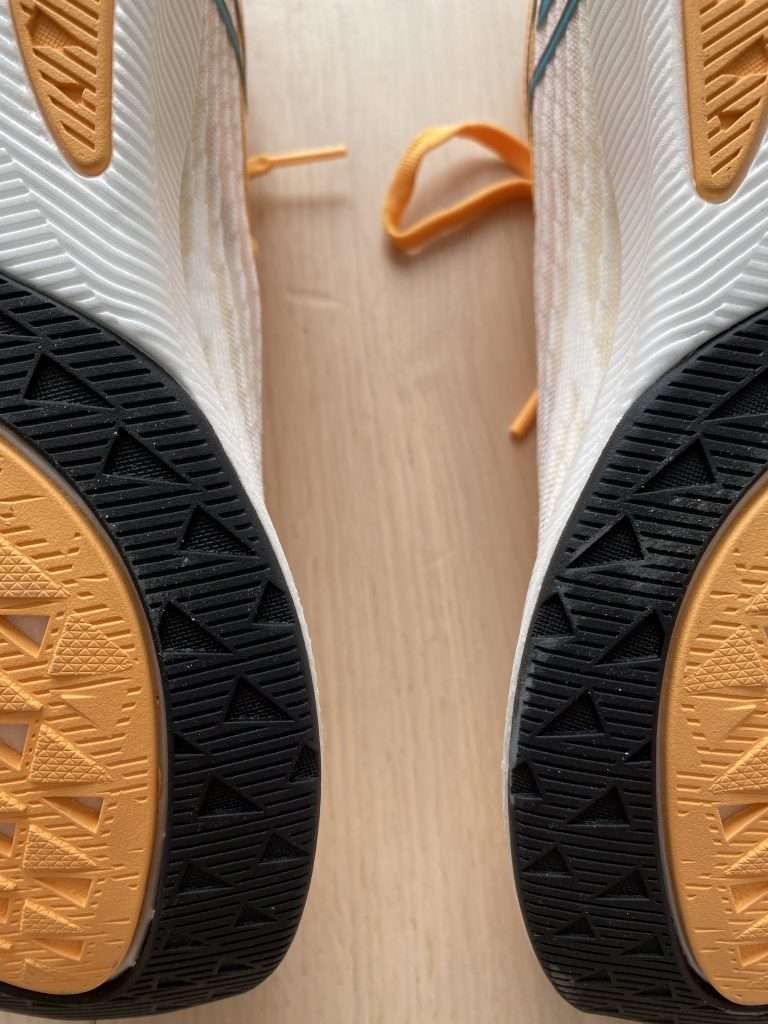The original Rebel kick started NB’s current performance line back in 2019. With the New Balance FuelCell Rebel v2, the company applies what they’ve learned in the meantime in their attempt to perfect their fastest daily trainer.
How does the second edition of the Rebel compare to its competitors in the heated market for fast trainers? Does it justify the outlay, and demand a spot in your running shoe rotation? If fast, lightweight and cushioned is your jam, it probably does. But our comprehensive New Balance FuelCell Rebel v2 review has all the info you need to make the right decision.

Fact Sheet
– Weight: 206 gr. / 7.3 oz. (US men’s size 9.5)
– Stack Height: 26 mm. / 20 mm.
– Drop: 6 mm.
– Support: Neutral (slightly unstable)
– Cushion: Soft
All gear is reviewed independently. When you purchase something through links in this article, Run161 may earn a commission. Learn more ›
Executive Summary
Short on time? Here’s the tl;dr •••Too Long; Didn’t Read version of our New Balance FuelCell Rebel v2 review:
Good 👍
- Lightweight
- Generous cushioning
- Bouncy and responsive ride
- Airy engineered mesh upper
- Locks the foot down well
- A great option for moderate medium long and tempo runs
- Excellent value for money at $130 MSRP
Bad 👎
- Lack of stabilising plate can translate to a wobbly feel at faster paces •••5:50/mile — 3:40/km or faster
- Poor surface grip in wet conditions

The Rebel is a great trainer at a favourable price point. Unless you’re partial to a firmer, more stable ride, odds are you’re going to like this shoe.
Convinced already? Check out this special offer from New Balance below! Or, read on for our full review before making a decision.
There’s a New Rebel in Town
I get it. You have the first version of the Rebel in your rotation. Maybe you love it, and you’re on your third pair. Or perhaps it wasn’t to your liking, and it’s mostly collecting dust.
Either way, it’s easy to fall into the trap of thinking that this is more of the same. That you know what this new running shoe is all about. I’m here to tell you that you don’t.
New Balance has launched a number of different shoes in their FuelCell foam fuelled (too much?) performance line since the original Rebel came out. While there have been some misses, the carbon plated FuelCell TC quickly became a favourite for many runners early last year.
Its racer sibling, the RC Elite, was generally well received as well. Limited availability, however, meant that many never even got a chance to try it New Balance’s first attempt to step up to the challenge of the Vaporfly.
With the Rebel v2, the company is looking to fine tune the recipe from the original by applying what they’ve learned since. The changes are plenty, and the upgrade is nothing short of a success.
What’s New With the Rebel v2?
The characteristic edge flare remains—though slightly muted—and ensures a visual resemblance to its predecessor. Beyond that, however, there are a number of tweaks:
- A completely redesigned mesh upper, compared to the single piece knit upper of the original
- The 26 mm. stack height of the Rebel v2 is a 2mm. increase compared to the original version
- Midsole rubber properties provides bouncier and more responsive cushioning than what was the case in the original
- Brand new outsole design consisting of “NDURANCE” rubber for better traction and transition
In short, the Rebel 2 has is, despite a name that indicates otherwise, a completely revamped shoe. Let’s get into the specifics of the various parts that make up the shoe.
Fit and Upper
True to size •••
The heel counter comes with just enough padding to prevent slippage while running. The fit of the FuelCell Rebel v2 is wide enough through the mid and forefoot to accommodate most runners. However, if you tend to prefer shoes specially designed for wide feet, you may find the Rebel v2 somewhat constrictive. An asymmetric split in the upper combined with offset lacing—reversed compared to what we’ve seen in the Nike Vaporfly Next%— works well. Pressure is evenly distributed across the top of the foot, and there are no noticeable hotspots. One point of note for those who use running power meters that measures air resistance. The offset lacing is likely to muddle your wind readings. As a result, you’ll likely see lower power numbers compared to shoes with a plain old straight split. We’ve already touched in on the FuelCell foam, and its varying properties across New Balance’s full range of performance shoes. But it bears repeating that FuelCell in one running shoe does not necessarily equal FuelCell in another. Speaking to RoadTrailRun, they company state: “The Fuel Cell (sic) family is our line of performance, speed and rebound driven shoes but contrary to popular belief is not a midsole compound thus the vastly different rides of different shoes within the family.” However, in the ad copy on their website, they frequently refer to the properties of the FuelCell foam. So, you’ll get a pass if you’re confused. Regardless, all you really need to know is that when it comes to “FuelCell” you’ll be wise to checking the reviews, or trying before buying, to know what you’re getting. As far as the FuelCell in the Rebel v2, rest assured that you’re getting the very best New Balance has to offer. If you’ve tried the carbon plated TC, you know the feeling. Impossibly responsive, propelling you forward through each step. The one significant drawback of the TC was its weight. With its premium racing shoe, the RC Elite, however, New Balance proved that they had perfected the midsole foam formula. It was lightweight, without compromising on the magnificent qualities of its trainer sibling. But what about the new Rebel? The second edition of the Rebel comes with the same compound as New Balance’s premium race offering. In other words, the impossibly bouncy, yet responsive and lightweight good stuff we saw in the RC Elite, and more recently in the second version of the premium racer. As a result, the first thing you notice when you pick up the Rebel v2 is that it’s unexpectedly lightweight. At first glance, the size of the midsole gives the impression that this will be a shoe with some weight to it. The contrast between this expectation and the shoe’s actual (lack of) weight makes the Rebel v2 feel almost like a toy when you first pick it up. Of course, it is anything but. When it comes to well cushioned trainers, there’s always a risk that soft midsole feels unresponsive and dead underfoot. My shoe shed is filled with maximalist shoes that are more reminiscent of sponges rather than trampolines. Safe to say, the Rebel v2 doesn’t disappoint in this regard. Despite a softer midsole compound than its predecessor, it somehow feels both faster and more responsive to the effort you put in. Such is the beauty of NB’s perfected FuelCell formulation. One reason high stack, well cushioned shoes tend to come equipped with a firm plate in the midsole is to add stability. The Rebel v2 doesn’t. All in all, the shoe doesn’t suffer much from this fact. Overall it becomes a less aggressive shoe as a result, more suited to training than racing. Just as intended. In terms of stability, however, it leaves you wanting. Although the relatively wide platform compensates somewhat, it is still not for those runners who prefer a stable and well supported shoe. For comparison, it’s no worse than its plated cousin, the previously mentioned FuelCell TC, and perhaps a hint more stable than a competitor like the Asics Novablast. When you speed up, the lack of plate means the instability becomes more pronounced. A firmer and more traditional fast training shoe like the Brooks Hyperion Tempo truly steps up once you get down to around 5:50/mile or 3:40/km pace. The Rebel v2, on the other hand, can feel a bit wobbly underfoot once you hit these paces. New Balance equipped the Rebel v2 with a brand new “NDURANCE” rubber outsole. As you can see from the pictures, the outsole covers most of the surface area of the shoe. A point of note is that the different rubber patches—which are colour coded to boot—have different properties. The black is the most dense and durable, while the red and yellow rubber patches seem softer, optimised for grip and traction. Overall, the shoe provides adequate traction in most circumstances. But, like others within its genre, the second edition Rebel feels slippery on slick, wet surfaces. Trying to run fast on wet, paved roads with a bit of surface water? Tread carefully, particularly through turns. After 100 miles of running, the Rebel v2 still holds up very well. The outsole shows little signs of wear, while the upper appears as new. Dirt and dust are the only signs of wear so far. We will come back and update this section with a more thorough analysis of the durability of the Rebel v2 as soon as we’ve logged another hundred miles or two in the shoe. Expect the update, complete with pictures, within a couple of weeks. If you want to make sure you don’t miss out on this update, subscribe to our weekly newsletter below. There’s no two ways about it: New Balance has a winner on their hands with the FuelCell Rebel v2. It’s everything you want in a lightweight daily trainer, and more: Feathery light on your foot with a great overall fit, and well cushioned, yet responsive and brimming with energy return. It is truly a versatile shoe, and a top choice everyday trainer. Only if you’re a runner partial to a more stable ride will you want to give the new Rebel a wide berth. And even then, the price point is low enough that it might be worth giving this shoe a go. Because in this current climate, there aren’t many high end trainers to be had for a $130 list price. You can purchase the women’s or the men’s model of the shoe straight from New Balance. Let me know by sending me an email at lc@run161.com.


Sole and Ride

Good FuelCell News

Snappy, Lively and Gets You Going
Unsuited for the Unstable
Outsole Traction




Wear and Tear
Verdict on The New Balance FuelCell Rebel v2
Like this?
